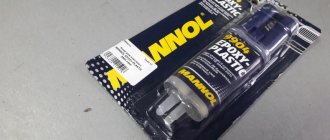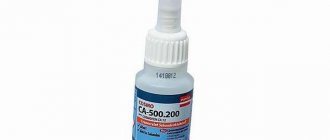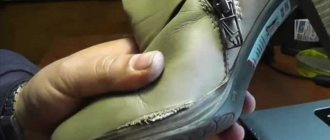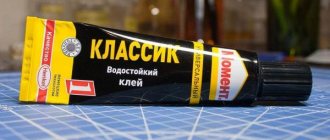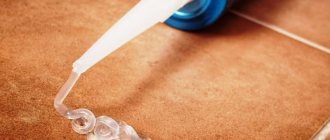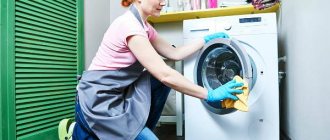Dichloroethane and that says it all!
This is a kind of glue - a solvent for plexiglass and plastics of a similar composition, just suitable for our taillights.
IF THE CRACK IS NOT LARGE AND COMES EASILY:
1. Coat the edges of the crack with dichloroethane
2. Wait 10-15 seconds for the edges to “float” and dissolve
3. We connect the edges of the crack with a little force, fix it so that they do not separate
4. Dry for 12-24 hours.
5. In the place of the glued crack, carefully pour a little dichloroethane and mix it over the surface, as a result we get a kind of smeared crack.
6. Let's repeat point 4 again
7. Now you can level the surface with fine sandpaper from 1000 to 2500 and polish.
IF THE CRACK IS WIDE, IT NEEDS TO BE FILLED WITH SOMETHING
To do this, in a glass jar, dissolve finely chopped pieces of plexiglass or plastic similar to the one being sealed with the same dichloroethane and fill the missing part in the crack with this mixture.
OF COURSE, it will not be possible to completely remove the cracks, but making them minimally noticeable is yes.
And last but not least, you can apply tinting varnish of the desired shade to hide the work done.
Probably the method is not so exclusive, but I tried this one myself.
There are several ways to repair a crack in a plastic bucket. You just need to familiarize yourself with the different options and choose the best one.
Determining the type of plastic
The type of plastic is indicated on each product with a special symbol. In the process of creating the code mark, the developers decided to apply it so that it would not be visible, so to see the corresponding symbols, you will have to carefully inspect the product.
Plastic can contain a large number of different substances, including very dangerous ones. If you learn to determine the composition of a material by labeling, then in the future you will protect yourself from purchasing harmful material and using it to store food.
The best waterproof adhesives
Waterproof compounds are used to join parts that are exposed to moisture. For example, this glue is used to connect pipes made of PVC and other plastic materials in the bathroom or kitchen.
Moment Crystal
This clear adhesive is resistant to moisture, dilute acids and low temperatures. It can be used in construction and repair work, as well as in embroidery. It can be used for gluing metal parts, plastic products, as well as plexiglass, polystyrene, soft and hard PVC, and is also suitable for processing glass, rubber, cardboard and other materials.
When working with Moment Crystal, it is desirable that the room is ventilated and there are no children or animals nearby. This is necessary due to the unpleasant odor this product has. In addition, gloves and a respiratory mask must be used while working. Opened adhesive should be stored in a dry and warm place, away from fire and heating devices.
Because it can easily ignite. In addition, if the product was transported or stored in a cold place, you must wait until it “reaches” room temperature before starting work. When using Moment Crystal, make sure products are dry and clean.
After this, apply the product to both parts of the product and connect them together. After 15 minutes, squeeze them well. The glued product will be ready for use within a day.
Volume “Moment Crystal” 30 ml. Use at temperatures not lower than +18 degrees.
Average cost 90 rub.
Advantages:
- resistant to frost, moisture and diluted acids;
- works with any material;
- comfortable tube;
- price.
Flaws:
- dries quickly after opening.
UNU Allplast
The basis of this product is acrylic. UNU Allplas is suitable for working with plastics based on synthetic resins. This product can be used both at home and not at work. It is often used in construction and repair work, as well as in embroidery for attaching decorative elements. In addition to plastic, UNU Allplas can glue glass, ceramics, wood and other materials.
To glue two pieces together, apply a small amount of glue to one surface and immediately attach the other piece. The connection will be tight but flexible. If the product has a porous structure, first apply the first layer of the product and let it dry for a couple of minutes. After this, a second layer is applied to one of the parts and immediately connected to the other. Maximum adhesion strength will be achieved within 24 hours.
UNU Allplas volume is 33 ml.
Average cost 205 rub.
Advantages:
- resistant to water, acids, gasoline and oils;
- not afraid of high and low temperatures;
- Suitable for working with any type of plastic.
Flaws:
- No.
Moment Plastic
Contact adhesive is designed for gluing soft and hard PVC, polystyrene, plexiglass and some other types of polymers. Not suitable for use with polyethylene, teflon and polypropylene. The composition reliably connects plastic objects, maintaining its properties when exposed to moisture and low temperatures (it has heat resistance in the range of -40... + 70 degrees).
Not afraid of exposure to diluted acids and alkalis. Thanks to transparency, the joining of parts becomes almost invisible. Aging resistance guarantees a long service life of the repaired product. Please note that the adhesive is not intended for use with items in contact with food.
Moment Plastic is applied to both pre-cleaned and dried surfaces to be bonded (to improve adhesion, it is recommended to sand and degrease them). Parts with the applied composition must be kept at room temperature for about 5... 10 minutes. Subsequently, objects can be connected by using force. The final bond strength depends on the pressure applied. Press the pieces together for a few seconds. You need to join the polymers carefully, since you won’t be able to correct the seam later. Since the adhesive contains toxic components, contact with skin must be avoided.
Advantages:
- high-quality bonding of plastic;
- transparency;
- affordable price;
- easy filling of cracks and chips;
- quick drying;
- water resistance.
Flaws:
- when exposed to high temperatures, there is a deterioration in the strength of the connection;
- toxicity.
UNU Creative
UNU Creative is a two-component epoxy adhesive. Suitable for working with any materials, including plastic, glass, wood, rubber, concrete, etc. The adhesive joint will be completely transparent and also resistant to stress and exposure to water and ultraviolet rays. It will be an excellent assistant in embroidery. It can fill holes and grooves, so it can be used to hold parts with uneven surfaces.
Before work, the bonded surfaces must be cleaned and degreased. When working with metal, it will need to be sanded. After this, you should start mixing the glue. You can do this in the cup provided or use a glass bowl. Both components must be in equal quantities. Mix thoroughly, the better the components are mixed, the better the connection will be. Once the mixture is ready, it will need to be applied to objects and pressed against each other. This should be left for 30 minutes. After an hour, the product will be ready for use, but complete drying will take about 12 hours.
The package contains two 15 ml tubes.
Average cost 485 rub.
Advantages:
- stick securely;
- suitable for any material;
- resistant to water, frost, acids and alkalis;
- the ability to add additional materials to the glue (sawdust, wood flour) and expand the scope of its application.
Flaws:
- does not bind thermoplastics.
Fortress Instant results
The multifunctional composition is suitable for fastening not only polymer materials, but also products made of wood, porcelain, leather, rubber, paper or metal.
The 3ml tube has a convenient embossed cap that helps break through the protective membrane. Additional protective cardboard packaging with a transparent “window” is provided. The container contains complete information about the product and how to use it.
Construction adhesive is made on a cyanoacrylate base. On average, he catches in one minute. However, for best results, the surfaces to be bonded must be thoroughly dried.
The advantages of the composition of the Chinese manufacturer are transparency, stable results and resistance of the bonded surfaces to moisture. This is the opinion of consumers who purchased the product. However, the consistency here is quite liquid, which can make work difficult, and the pungent smell cannot be considered beneficial.
Advantages:
- glue several surfaces;
- dries in 60 seconds;
- not so expensive;
- convenient packaging;
- moisture resistant.
Flaws:
- strong smell;
- very liquid.
SinTex glue
Quick-drying all-purpose adhesive for home use. Adheres tightly to plastic and other materials. Available in spray bottles for convenient and economical application. Not afraid of water and extreme temperatures. Has a transparent color.
Advantages:
- glues different surfaces.
- dries quickly.
- convenient packaging.
- economical consumption.
Flaws:
- strong smell.
New SGU-450
Powerful spray adhesive for plastic, leather, glass, rubber, leather and fabric. After spraying, a thin layer is applied to the surface, after drying it remains unnoticed. It has a high level of moisture resistance, which allows it to be used in basements, kitchens, showers, and bathrooms.
Advantages:
- high-quality gluing;
- works with any material;
- comfortable tube;
- waterproof.
Flaws:
- strong smell.
STAYER BlackPRO WATERPROOF
One of the best waterproof representatives. The product is able to work with all materials, providing a reliable and durable connection. For more effective adhesion, it is important to apply the fluid at a temperature of +10 degrees.
The average price is 194 rubles.
Advantages:
- reliability;
- universal;
- popular manufacturer;
- per package 280 ml.
Flaws:
- not found.
What does the marking on plastic mean?
The marking is determined by seven numbers, each of which will indicate to you the composition and purpose:
1 - The composition under this number is called polyethylene terephthalate (PET). Various containers and cling film are made from this material.
2 - This is pure polyethylene (HDPE), from which bags and similar low-density containers are made.
3 - The substance is polyvinyl chloride (PVC), which is used to make window frames. It is prohibited to be used as a food product, but it is polyvinyl chloride that is made in the form of caps for plastic bottles.
4 - High-density polyethylene (LDPE) is used to create children's toys, greenhouse film and plastic pipes.
5 - Propylene (PP) is most common in everyday life. Syringes, hot water pipes and dishes are made from it, as this material has good resistance to high temperatures.
6 - The number indicates a material called polystyrene (PS). It is used to make containers for yogurt and the lining of chambers of modern refrigerators.
7 - This group includes other materials that are not included in any of the above markings. This is foil or some kind of polymer used as a container for milk or juice.
By remembering these markings, you will learn to determine the composition of the plastic and the relevance of its use. All elements differ in density, flexibility, resistance to cold or heat, respectively, and gluing to each other or other elements.
The best heat-resistant adhesives
Modern plastic can withstand very high temperatures. When gluing bases made of such material, special heat-resistant adhesives must be used.
Akfix ht300
Sealant resistant to high temperatures and moisture. The main component is silicone, which hardens when exposed to moist air. Thermal resistance of the composition is up to +300 °C.
Elite dragon
A polymer mixture that holds together plastic, parquet, ceramics, wood, etc. It has high adhesive characteristics and is resistant to high temperatures.
Mastix epoxy termo
Two-component composition of Russian production. Tubes with a total weight of 50 g cost 67 rubles. The product glues polymers, glass, metal, wood, and ceramics. After polymerization is completed, the seam is maintained at t=+250 °C. It is epoxy and contains fillers and hardeners. Has a viscous consistency.
Both components are mixed in the same ratio. The resulting mass is applied to both surfaces to be glued. Complete hardening of the seam occurs after 5-6 hours at room temperature. The seam can withstand high temperatures, frosts down to -60 °C.
Avoid contact with skin and mucous membranes.
Rexant glue sticks
Rods from a Russian manufacturer are available in different thicknesses, lengths, and colors. Single rods or sets of 10-12 pieces are sold. Set price for 10 pcs. – 207 rub. The product sets quickly, forming a strong, elastic, heat-resistant seam. Apply with an electric gun. You can join paper, synthetic fibers, plastic, glass, leather and metal surfaces. The main disadvantage is the mandatory presence of a glue gun.
What glue to glue plastic with: types of glue
Before you start gluing plastic elements at home, it is recommended that you familiarize yourself with the types of suitable glue. This will help you choose the correct classification and properly glue the elements together.
Liquid
It is considered the least effective means for gluing plastic. Used to connect surfaces that are not subject to regular loads. For complete gluing, the parts must be left for at least 20 hours. The advantage of this type of glue is that it does not deform the plastic.
Contact
The glue comes complete with a hardener, which is mixed in the prescribed proportions. Contact type is considered one of the strongest adhesives, but it is toxic. Before use, it is recommended to wear protective gloves, a mask or a respirator.
Reactionary
The most suitable adhesive for gluing plastic. It consists of epoxy filler, polyurethane, various solvents and resins. Depending on the composition and purpose, the adhesive is used in cold and hot areas, as well as in water. Due to a unique combination of substances, it firmly holds plastic together even with regular mechanical stress.
Hot melt adhesive
The glue spreads in a solid state, in the form of a rod. It is loaded into a special pistol and begins its action when heated. The substance does not provide good adhesion, so it is used only when connecting small parts.
The best superglues for plastic
The most popular method for gluing broken parts or assembling miniature models is superglue. The name itself speaks of the extraordinary speed of gluing and high bonding strength. Among the huge variety of tubes, experts have identified several products.
Universal Moment Super Second
When quick fixation is needed, Henkel's Super Seconds are a big help. Since this model is universal, it can be used to fasten objects made of plastic, wood, ceramics, porcelain or rubber. It is also suitable for porous products with high absorbency properties. To do this, apply a thin layer of “Super Second Moment” to one of the surfaces of the part, after which you must immediately apply another part. Both parts must be tightened and held for a few seconds. Immediately after this, the fixed elements are ready for further use. It is best to work with gloves and a mask. Because if the product gets on the skin, it will instantly stick. Super Seconds should not be used on utensils that are used for eating or cooking.
One tube contains 3 grams of glue.
Average cost 55 rub.
Advantages:
- instant capture;
- suitable for any material;
- transparent seam;
- price.
Flaws:
- strong smell;
- the product remains in the tube;
- dries quickly.
Second super instant
This cyanoacrylate product is suitable for gluing parts made of any materials. It is designed to work with leather, plastic, porcelain, metal, rubber and cardboard. "Super Flash Second" is waterproof, suitable for both outdoor and indoor use. It will cope with its task in the temperature range from -30 to +50 degrees. And gluing takes only three seconds.
One tube contains 20 grams of the finished product, which is enough for a large amount of work. With a convenient lid, you can easily store leftover glue until your next need.
The average cost is 120 rubles.
Advantages:
- volume;
- dries in 3 seconds;
- Suitable for all materials.
Flaws:
- No.
Super glue "CONTACT"
An excellent two-component option, suitable for gluing products made of ABS, polypropylene, etc. Provides reliable fixation for several years. The seam is almost invisible and does not stand out over time.
Sold at a price of 230 rubles.
Advantages:
- perfectly glues synthetic elements;
- reliability;
- good composition;
- useful marker.
Flaws:
- high price.
BRAUBERG for plastics
An excellent universal product suitable for all types of work. Thanks to the high density of the adhesive, this reduces consumption. It has found application both in creativity and tasks, and in the creation of complex products in laboratories. A special cap allows you to reuse the product several times.
Average price 12 rubles.
Advantages:
- reliable adhesion to the surface;
- compound;
- reusable;
- waterproof.
Flaws:
- setting time: up to 60 seconds.
Henkel Super Moment Maxi
Instant bonding of plastic and plastic is highly appreciated by professionals. Not all adhesives are up to the task, but Henkel's Super Moment Maxi is up to the challenge. It not only fastens quickly, but also securely binds different materials. In addition to polymer parts, the composition can glue metal, cardboard, ceramics and porcelain.
The manufacturer has made soft and comfortable packaging and an elongated tube spout. This made it possible to carefully and economically apply the glue, without the master’s hands being in the solution. The cap is easily removed and, when closed, prevents air from entering the tube.
Average price: 292 rubles. (20 g)
Advantages:
- instant adhesion to the surface;
- economical consumption;
- adhesives and other materials;
- gluing quality.
Flaws:
- not found.
Superglue POWER
High-quality superglue STRENGTH is sold on the domestic market at an affordable price. At the same time, the composition firmly adheres to plastic, plastic, porcelain, glass, leather and wood. Thanks to the convenient tube, the required amount of glue can be applied precisely to the surface of the workpiece.
This has a positive effect on consumption. Experts note the absence of diffusion; the gel does not drip onto other objects or hands. The product is based on ethyl cyanoacrylate with the addition of thickeners. After drying, the adhesive seam becomes transparent, which is important when gluing white or colored materials. The adhesive strength during testing was 175 N.
Average price: 50 rub. (3 g)
Advantages:
- glues quickly;
- convenient to use;
- no pungent odor.
Flaws:
- not often enough.
Economy Express Universal
Universal Chinese superglue Econ Express has an instant effect. It is easy to use, quick to set up, and unpretentious in operation. The composition is suitable for gluing plastic and plastic, metal and paper, rubber and porcelain. Experts note the high strength of the adhesive seam, which can withstand a load of 210 N. The use of glue is quite standard, the surface of the parts is cleaned and degreased, applied to one of the parts, the compression time is 5. -60 seconds.
Users note the low price of the composition, good quality and reliable tailoring. Even under the influence of water, the glued parts do not peel off. Consumers also respond positively to the sealed lid, which prevents air from leaking through. Disadvantages include a strong odor, which can cause headaches when working in a small, unventilated room.
Average price: 33 rubles. (3 g)
Advantages:
- affordable price;
- reliability;
- sealed hood;
- waterproof.
Flaws:
- strong smell.
Permatex Super Glue
Superclue Permatex Super Glue with a gel-like consistency has high adhesive strength to plastic. During comparative tests, experts from the magazine “Behind the Wheel” recognized it as the winner. The destruction of the adhesive seam occurs under a load of 245 N, which significantly exceeds the performance of competitors. In addition, the practicality of using glue when it is necessary to glue thin parts is noted. The product is recommended for gluing hard-to-reach and vertical surfaces. High adhesion strength is observed on non-porous plastics.
Average price: 126 rub. (2 g)
Advantages:
- sets quickly;
- easy to use;
- transparent seam;
- economical consumption.
Flaws:
- No.
Popular brands of glue for plastics
Let's highlight the best manufacturers of glue for gluing plastic parts:
- "Star". Budget adhesive designed for gluing plastic parts. Drying time is a day. Among the minuses, we highlight the lack of additional tools and the inconvenient shape of the container.
- "Second". Glue comes in liquid and gel form. Transparent color allows you to glue parts without stains or marks. Complete drying time – 2 hours. It also glues glass and wood well. It is stored mainly in tubes.
- Tamiya. The substance is intended for gluing small plastic parts. A brush is included. The advantage of the glue is its aromatization. As you work, you will smell lemon.
Each manufacturer produces glue with unique characteristics and capabilities, so you can choose the most suitable one for the connection.
How to learn to read markings on glue?
The problem is that it doesn't match the plastic recycling signs.
- PC - polycarbonate.
- ABS is an acrylonitrile copolymer.
- PP - polypropylene.
- PS - polystyrene.
- PPMA is a general purpose organic glass.
- PE - polyethylene.
- PVC - polyvinyl chloride.
- PA 66 - polyamide.
- PUR - polyurethane.
The ability to distinguish these markings will not be enough to choose the right glue, so you need to understand this issue in more detail.
Examples of waterproof glue
Moment plastic
One of the best contact agents, produced in Russia. The average cost of a tube weighing 30 grams is 60 rubles. Reliably holds plastic and polyethylene together, dries quickly, retains its properties under the influence of moisture, temperature changes, acids, salts, alkalis and other aggressive chemicals of inorganic origin. After drying, a transparent seam remains. It is recommended to protect your skin from this product, as it contains toxic substances.
3m scotch weld pr100
It has an epoxy composition and bonds firmly to plastic. It hardens completely 20 minutes after application to the surface. Can interact with different types of plastic, waterproof.
Loctite 406
This plastic adhesive is made in Ireland but is a German brand. Reliably connects smooth and rough surfaces. One package contains 20 grams, its cost is approximately 635 rubles. It has a high polymerization rate, low viscosity and resistance to temperature fluctuations from -40 to +80 degrees Celsius. When interacting with plastic, no gap appears at the junction of the parts. But this product also has disadvantages: a strong toxic odor, high price, and is not suitable for all types of plastic.
Star
It is inexpensive and the adhesive is suitable for many types of plastic. It dries completely a day after application to the surface of the product.
Second
This glue comes in two forms: gel and liquid, and does not leave a stain after gluing. Dries completely after 2 hours. Mainly stored in tubes.
Tamiya
Glues small parts well, sold with a brush. This product has a special feature: it has a lemon scent.
How to glue plastic
When gluing plastic parts together, you need to adhere to a certain sequence, otherwise you may end up with uneven parts, and you will have to go through a lengthy process of separation and cleaning to reconnect them.
Sequence of work
Immediately clean the area to be glued with a soap or alcohol solution. Then we increase the absorbency using sandpaper. Apply glue so that there is no excess, otherwise smudges will appear. When gluing, the parts must lie flat and tight to each other; after applying the substance, you need to restrain them for a certain time, depending on the brand of glue.
How to glue plastic using superglue and soda
When liquid glue and baking soda are combined, a chemical reaction occurs that speeds up the drying process and enhances bonding by increasing the temperature. To glue plastic using this method, you need to act consistently. After cleaning and sanding, cover the joint area with a small layer of baking soda, then pour the glue onto the soda, connect and wait for 1.5-2 hours to dry. For the best effect, treat the glued part of the plastic with micro-grained sandpaper.
How to glue plastic with dichloroethane
Dichloroethane is a very caustic substance, so when working with it you need to be completely protected from direct contact. When applied to plastic, the second one begins to dissolve, so you need to work with dichloroethane carefully, observing the correct proportions.
To glue plastic parts, apply a thin layer of a toxic substance using a brush and wait 10–15 minutes. and repeat the procedure. This method is considered the most effective, since the dissolved parts of the plastic merge into one whole. The disadvantages of such gluing include the possibility of deformation.
There is an alternative method of using dichloroethane. Pour the toxin into a metal or glass container and add pieces of similar plastic that will stick together. When a homogeneous thick mass is achieved, apply it to the joint. This will allow you to hide the seam.
How to glue products with a decorative outer surface?
If you apply glue to a decorative surface, traces of it will be visible. In this regard, the option of gluing parts in the internal part remains. To do this you will need fiberglass or any durable material. We clean the inner area to be glued, thoroughly saturate the fabric with glue and apply it tightly to both parts.
If the inside cannot be glued, then all that remains is to use rubber or gel glue. These substances take longer to dry, so you have the opportunity to eliminate excess during the bonding process.
How to glue a crack in plastic
Gluing a certain type of plastic requires glue of the appropriate marking. In the future, everything will depend on the connection location and the functions of the parts. For water containers we use a waterproof substance; in other cases it is better to use gel or liquid glue.
To glue the crack, it is important to use a strong fabric. After treating the joint area, saturate a rag with glue and carefully press it on both parts. If this method is not suitable, then we create multi-layer gluing. A gel-like substance is suitable for this, since it takes a long time to dry. Apply a thin layer of glue to the crack and wait until it dries, then repeat the procedure 2-3 times. For better effect, you can use baking soda.
How to glue plastic glasses frames
We clean the contact points with acetone or alcohol and apply a thin layer of glue to the broken points. For convenience, you can use a wooden ruler to fasten between the ears of the glasses. This will allow you to connect the parts as smoothly as possible. For small jobs, liquid glue is suitable.
How to glue plastic headphones
For plastic parts that are subject to constant mechanical stress, epoxy adhesive is suitable. If the headband of the headphones breaks, glue the required area several times. You can also install a bracket to connect the parts, which is also glued.
How to glue radiator plastic
The car radiator consists of hydrophobic plastic, which is difficult to glue. To connect the radiator parts you need to use a special glue, but even this will not hold the plastic tightly together. When the car is driven, all parts vibrate, so gluing the radiator is more of a temporary measure.
How to glue a plastic denture
If a crack appears on the prosthesis, the best option is to go to the clinic. The doctor will glue it together using a special medical glue that best matches the type of plastic. However, you can do this yourself using one of the common types of glue. Only dichloroethane is suitable for the prosthesis; other options will cause an allergic reaction or will not last long due to their constant presence in the mucous membrane.
Self-gluing the parts of the prosthesis will only give a temporary effect, and only a medical technician with the appropriate equipment can eliminate defects and the visible part of the connection.
How to glue plastic with cosmofen
Cosmofen is a famous brand of glue that is used in almost every industry. The best bonding occurs when paired with plastic, but cosmofen firmly bonds rubber and wood. The substance is not toxic, but contact with food should be avoided.
The gluing process is standard: we clean the joints from dirt and burrs, then apply acetone or alcohol, and only then apply the glue itself. Cosmofen sets in 1-2 minutes, but complete drying will occur within 24 hours.
How to glue plastic on a scooter
Workshops typically use special tools and welding. Not everyone has the appropriate equipment at home, so consider the method of gluing with glue or cold welding.
We clamp the plastic into a cleat, take coarse sandpaper and carefully rub the inside of the damaged plastic. This will allow the glue to absorb better and hold the parts more firmly. Then we apply the substance to the gluing area and saturate a thick piece of fabric with it. We connect the plastic at the chip site and let it dry for 3-5 minutes. We impregnate the fabric with glue or cold welding and apply it so that it covers the entire damaged area. Let it dry again and reapply glue.
How to glue greasy plastic
This type of plastic does not adhere well, so the substance should be selected for maximum adhesion properties. You can glue fatty plastics with cyacrine, rubber or gel glue. These substances are the most suitable, but they still contribute to temporary fastening. For an acceptable result, it is recommended to use welding and woven gaskets. This applies only to the damaged part that is not subject to mechanical stress.
How to glue plastic with acetone
Only ABS grade acetone will dissolve plastic, so make sure it is labeled before proceeding. The essence of such a connection is to create an adhesive mass using a solvent. Throw small pieces of plastic into a container with acetone and wait about 30 minutes. until it dissolves. A thick mass will be created, which we use as glue. The solvent takes a long time to erode, so it is recommended to fix the damaged part in cleats. After the acetone has completely dried, the parts will be firmly connected, creating a homogeneous mass.
How to glue plastic on a mirror
Before the procedure, you need to examine the part and find out the plastic markings. The decor is glued from the inside. We take fiberglass and impregnate it with epoxy resin. The size of the rag should be twice the size of the area to be glued. Superglue or a similar liquid substance is not as effective, since regular vibration will cause the crack to delaminate.
How to glue plastic with a soldering iron
Before the procedure, you need to cut pieces of plastic according to the shape of the crack. The plastic markings must match. We clean the damaged area from dirt and grease and apply the cut plastic to the chip site. We heat the blowtorch and slowly run it along the crack until the molten plastic fills the space between the parts being joined. While the substance has not dried, it needs to be cleaned; this can be done with any flat, durable object. We repeat the procedure several times, after which we let it dry completely.
How to glue plastic from bottles
When gluing plastic bottles, Moment glue is the best. Other substances show weak attachment, or even completely corrode the plastic. More often than not, bottles are distributed with a smooth sliding surface, so before gluing, you need to sand the plastic area with sandpaper. Another advantage of Moment is that it is transparent, which means it will practically not be visible on plastic.
Features of choice
When choosing an adhesive, you need to consider the type of plastic. To do this, each product is marked in the shape of a triangle with arrows:
- PETE is the most common polyethylene, a thermoplastic used to make food containers and packaging materials. Often used in the production of electrical and radio components, containers for cosmetics.
- PVC is plasticized polyvinyl chloride, a universal material used in the production of the vast majority of items: furniture, building materials, various parts, containers for food products.
- LDPE is a thermoplastic considered a good thermal insulator. It is used to make pipes, packaging, and toys.
- PP is durable, rigid, the cheapest polypropylene, considered a cheap and popular plastic. It is used in the production of sewer pipes, automobile parts, and various tools. Excellent resistance to aggressive substances and temperature changes.
- PS polystyrene is a thermoplastic polymer that is resistant to chemicals and moisture. One of the common types of plastic from which furniture, dishes, and heat-insulating coatings are created.
- Other and other types of plastic, to which various polymer elements are added. Not reused. It is characterized by high strength.
The tube must be sealed, undamaged, and contain information and detailed instructions. To repair toys, you should purchase a solution based on BF glue.
Valera
The voice of the construction guru
Ask a Question
It is advisable to choose packaging of a volume that is sufficient for repairs, so that there is no surplus left. Despite the tight closure of the lid, the fixing compounds are prone to drying out and losing their adhesive (adhesive) properties.
When choosing an adhesive, you should consider the material to which the plastic is glued.
When purchasing an adhesive, it is important to consider the material to which the plastic is attached : paper, leather, metal, wood, etc. If the product is planned to be used outside or in places with high humidity (kitchen, bathroom, shower), moisture-resistant types are used. When working with contact adhesive compositions, ensure ventilation and ventilation.
One-component and two-component adhesives for plastic have their own markings in the form of letter abbreviations. For example, PPMA (plexiglass), PP (polypropylene), PA 66 (polyamide), etc. For ordinary consumers, these designations do not have much meaning, since any adhesive for plastic has instructions that indicate the types of plastic suitable for gluing.
How to achieve maximum effect when gluing
In order for the plastic to adhere well, you need to carry out the procedure sequentially:
- we determine the markings of the plastic and select the appropriate glue;
- clean the surface of the plastic with acetone or alcohol;
- when gluing from the inside, clean the surface with sandpaper;
- After fastening, wait as long as required according to the instructions.
If you are unable to determine the type of plastic, then drop some glue onto the desired surface and watch the reaction. If the plastic has not dissolved and the glue is firmly attached, then the substance matches the material.
Industrial dryer
An industrial hair dryer for performing household welding of polymers has the most minimal functionality, but allows you to easily eliminate cracks, as well as restore the integrity of various plastic products.
Work technology:
- Place a plastic rod into the crack.
- Heat the plastic and edges evenly with a welding hair dryer.
- Melt the rod completely before mixing it with the plastic.
- Wait until the seam hardens evenly.
After cooling, all excess is removed from the surface, and the welding area is carefully sanded using fine-grained sandpaper or a grinding wheel.
A burst or cracked bucket can be sealed or welded, but any such measures are considered to be exclusively a temporary control measure, and further destruction of the plastic is an irreversible process.
How to glue plastic without glue
There are several ways to glue plastic without using glue:
- Dichloroethane. The toxic substance can dissolve plastic. When mixed correctly, you will get a thick solution, which is subsequently used as a binder.
- Soldering iron or heating pad. This method requires an experienced approach, so it will be difficult to fix the plastic with a soldering iron yourself. Using a blowtorch, we directly melt the seams of plastic or use material of the same marking as a connector.
- Acetone. Degrease the surface of the plastic and use a brush to moisten the crack or chip. Then we firmly connect the material together and also apply acetone. A slight dissolution of the plastic will create a soldering effect and firmly hold the part together.
Rules for gluing plastic
After determining the type of plastic and choosing the appropriate adhesive, you should begin repairing the damaged product. The scheme for gluing plastic at home looks like this:
- Cleaning the part.
Parts should be degreased with ethyl alcohol or soapy water.
Apply glue only to a clean surface with better adhesion.
If possible, glue on the inside so that the seam is invisible.
- Surface cleaning.
Roughen the plastic with a thin cloth for better adhesion.
- Mix two-component adhesives (after preparing plastic products).
The adhesives come with instructions describing the process of diluting the substance. Typically, the compositions are mixed in a special container in a ratio of 10: 1, where 10 parts are epoxy resin, 1 part is hardener.
- Tool.
The product is applied with a gun, brush, or by extrusion from a tube. When working with a brush, you should give preference to a tool with artificial hair.
- Control of the amount of solution.
When extruding glued parts, be careful not to let excess leak out. Apply a thin layer to the crack (make sure the compound is on each side of the “break”), for small cracks use a needle. Place fiberglass cloth on the treated surface and apply glue again.
- Squeeze tightly, but carefully glue the parts.
Make sure that the plastic parts do not slide relative to each other in the gluing plane. The holding time depends on the adhesive used: the type of contact sets quickly, a strong squeeze and a few minutes are enough, while epoxy resins harden within a few hours, but do not require strong compression.
The plastic should be secured with clips, staples or other fastening devices.
When working with epoxides and other toxic substances, use personal protective equipment (safety glasses, mask, rubber gloves). There must be ventilation equipment in the room where gluing occurs.
Note: Epoxy adhesives cure both hot and cold. Temperature range from -10 to + 200 oC. Hot curing is typical in industries where active chemicals are also used in addition to high-level heat treatments. At home, plastics are combined with plastics by cold curing.
Is it possible to cold weld plastic together?
Cold welding can be two-component or one-component. In the first case, you mix two substances and get an adhesive. One-component welding is sold ready-made, so you only need to knead it a little and apply it to the damaged surface.
When welding plastic items, the main thing is to select the appropriate markings, otherwise the plastic elements will not receive good bonding. Each type of cold weld can withstand a certain temperature, so check the characteristics of the substance on the packaging before purchasing.
The gluing procedure is similar to standard glue: clean the surface and apply the substance in thin layers. If the weld hardens during the process of joining the plastic, this can be corrected with a hairdryer. Once warmed up, the cold weld will become elastic and you can reshape or remove it.
How can I repair a plastic container?
Operating procedure:
- Cut off a piece of mesh with scissors.
- We fix the mesh at the site of damage to the depth of the mesh thickness.
- Align it along the seam, moving along the entire plane. ...
- Using this method, we insert the entire mesh into the seam.
- At the end of the work, the seam is completely sealed and reinforced, which gives it strength.
Interesting materials:
How many types of copyright are there? How many types of activities are there in OKVED? How many types of eucalyptus grow in Australia? How many types of gymnosperms are there? How many species of vertebrates are there? How many plant species did Carl Linnaeus describe? How many types of compound sentences are there? How many types of Uud? How many species of animals did Linnaeus describe? How many virtual tables does the accumulation register have?
How to glue plastic with epoxy resin and fiberglass (epoxy glue)
Epoxy resin hardens quickly, so we prepare all components in advance before the procedure. We apply the epoxy substance to the joint in several layers. Leave for a few minutes and apply tightly to the joint. We completely saturate the fabric and press it to the joint. For better effect, perform the procedure 2-3 times. Let the surface dry for a day.
Epoxy resin
If something needs to be glued together for years, epoxy resin is the best option. And regardless of the brand chosen, each of them shows excellent gluing results. The hardeners contained in epoxy resin are resistant to all types of influence, including acids. Many craftsmen also make jewelry from epoxy resin. They place a flower or any other object in a mold and fill it with resin. The resulting pendant can faithfully serve its owner for many years.
How to glue plastic with hot glue (hot glue gun)
Hot-melt adhesive is distributed in a solid state in the form of a rod. The adhesive effect appears after increasing the temperature. To ensure a high-quality connection of plastic, it is recommended to use a special gun. The tool comes in different capacities and differs in the process of application, so you should choose the most appropriate one. Due to its weak strength, glue is used more often in modeling, when gluing small fixed parts.
When you press the trigger, the substance heats up and it becomes ready for gluing. This type of connection is intended for modeling or connecting decorative elements that are not subject to frequent mechanical stress. The advantages include convenience and ease of use.
Before connecting, we charge the gun with a rod and clean the area of grease and debris, thereby warming the surface so that the substance does not harden prematurely when applied. Then we pull the trigger of the gun and begin to move it along the area to be glued until the desired layer of hot-melt adhesive is applied.
Product examples
What can be found on the shelves of construction and hardware stores:
- “ Moment plastic” is a type of glue that connects many types of plastics. It has a transparent base, sets quickly and forms a strong connection. This is a waterproof and heat-resistant composition. However, it contains toxic substances and is not used to repair products that come into contact with food or skin.
- “Super Moment ” - second glue.
- 3M Scotch-Weld PR100 is an epoxy adhesive that hardens in 20 seconds. Simple and easy to use composition.
- Cosmofen is a brand that offers several types of glue for plastic. Among them are adhesive-sealant for transparent plastic, Plus composition for PVC, PMMA - adhesive for polystyrene and acrylic surfaces.
- " Second " - superglue for hard plastics. One of the fastest acting compounds.
- For minor car repairs, special automotive plastic sealants are sold.
- Rexant is a hot melt adhesive, available in the form of rods. It can be transparent or colored (to disguise joints if colored parts are connected).
- Akfix HT300 is a heat- and water-resistant composition. Withstands temperatures up to +300 degrees. This adhesive sealant contains silicone. It reacts to humid air.
This is not the entire range that the adhesive industry offers. It cannot be said that any glue is better or worse. Each composition is designed for specific types of work. Read the instructions carefully and follow all recommendations.
Rexant and Akfix HT300
How to glue plastic to rubber?
Here everything will depend on the further use of the plastic item. If it is not subject to regular stress, then rubber cement will do. When using the substance for its intended purpose, follow the instructions. Among the disadvantages, we note long drying time and low resistance to water.
Moment glue and its analogues are also suitable. We apply the liquid gel-like substance tightly to the parts that have been previously cleaned of dirt and dust. It is better to place a heavy object on the joint and leave it to dry for 24 hours.
You can glue plastic surfaces from any materials, and regardless of whether they are subject to stress or not, you can always choose the most effective substance. The main thing in the gluing process is marking. If you know the type of plastic, you can select the appropriate glue and tightly fasten the elements.
What affects the reliability of gluing
The reliability of the seam is influenced by a number of conditions. All of them are important, and failure to comply with any one can lead to the fact that what is glued at home will fall off, despite compliance with all the others. So:
- Compliance of the product material and adhesive composition.
- Correspondence of the type of adhesive composition to the magnitude of the forces that the connection will experience. The direction of these efforts is equally important. Thus, compounds that produce rigid seams are not suitable for repairing, for example, shoes - after all, the sole will bend and twist during use, despite the fact that the tensile force will be small. At the same time, this composition can successfully glue, say, a hook to glass, and hang tens of kilograms on it.
- Compliance with application technology. Everything is important here - how many seconds or minutes the surfaces need to be compressed, and how to degrease them, and how long to keep the parts pressed against each other. All this depends on the properties of a particular “plastic-glue” pair, is described in detail in the instructions and must be followed verbatim. A deviation of one second in the exposure time or premature start of use of the product can lead to secondary failure.
- Mechanical part of the process. It is important to thoroughly clean the surface from dust and roughen it. In addition, the direction of pressing the parts against each other must be perpendicular to the surfaces being glued. You should not allow the parts to move mutually after pressing - this will also lead to failure.
Gluing plastic tightly is not so easy. Carefully following simple rules by the home craftsman will allow you to obtain strong and durable connections. The main thing is not to forget about safety precautions: do not inhale vapors of the adhesive and do not allow it to get into food, skin or mucous membranes. If accidentally swallowed, consult a doctor immediately, making sure to take the tube with you.
Tips for gluing plastic
To make the gluing process successful, you should follow a few simple but useful tips:
- use suitable solutions and plastics;
- Follow the instructions;
- do not use glued products before the expiration date;
- choose waterproof products for outdoor use;
- remember that if the manufacturer claims that they are heat-resistant, the plastic parts may not withstand high temperatures;
- ventilate the room where you work;
- if there is no marking on the plastic, it is most likely polystyrene foam.

